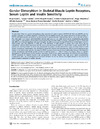Identificador persistente para citar o vincular este elemento:
http://hdl.handle.net/10553/6542
| Título: | Gender dimorphism in skeletal muscle leptin receptors, serum leptin and insulin sensitivity | Autores/as: | Guerra, Borja Fuentes, Teresa Delgado-Guerra, Safira Guadalupe-Grau, Amelia Olmedillas, Hugo Santana, Alfredo Ponce-González, Jesús Gustavo Dorado, Cecilia Calbet, Jose A. L. |
Clasificación UNESCO: | 2411 Fisiología humana | Palabras clave: | Leptin Testosterone Fat |
Fecha de publicación: | 2008 | Proyectos: | Mecanismos Fisiológicos y Moleculares de la Reducción de Masa Grasa en Seres Humanos Mediante Ejercicios de Musculación. | Publicación seriada: | PLoS ONE | Resumen: | To determine if there is a gender dimorphism in the expression of leptin receptors (OB-R170, OB-R128 and OB-R98) and the protein suppressor of cytokine signaling 3 (SOCS3) in human skeletal muscle, the protein expression of OB-R, perilipin A, SOCS3 and alpha-tubulin was assessed by Western blot in muscle biopsies obtained from the m. vastus lateralis in thirty-four men (age = 27.1+/-6.8 yr) and thirty-three women (age = 26.7+/-6.7 yr). Basal serum insulin concentration and HOMA were similar in both genders. Serum leptin concentration was 3.4 times higher in women compared to men (P<0.05) and this difference remained significant after accounting for the differences in percentage of body fat or soluble leptin receptor. OB-R protein was 41% (OB-R170, P<0.05) and 163% (OB-R128, P<0.05) greater in women than men. There was no relationship between OB-R expression and the serum concentrations of leptin or 17beta-estradiol. In men, muscle OB-R128 protein was inversely related to serum free testosterone. In women, OB-R98 and OB-R128 were inversely related to total serum testosterone concentration, and OB-R128 to serum free testosterone concentration. SOCS3 protein expression was similar in men and women and was not related to OB-R. In women, there was an inverse relationship between the logarithm of free testosterone and SCOS3 protein content in skeletal muscle (r = -0.46, P<0.05). In summary, there is a gender dimorphism in skeletal muscle leptin receptors expression, which can be partly explained by the influence of testosterone. SOCS3 expression in skeletal muscle is not up-regulated in women, despite very high serum leptin concentrations compared to men. The circulating form of the leptin receptor can not be used as a surrogate measure of the amount of leptin receptors expressed in skeletal muscles. | URI: | http://hdl.handle.net/10553/6542 | ISSN: | 1932-6203 | DOI: | 10.1371/journal.pone.0003466 | Fuente: | Plos One[ISSN 1932-6203],v. 3 (10) |
| Colección: | Artículos |
Citas SCOPUSTM
52
actualizado el 05-may-2024
Citas de WEB OF SCIENCETM
Citations
49
actualizado el 25-feb-2024
Visitas
74
actualizado el 10-feb-2024
Descargas
47
actualizado el 10-feb-2024
Google ScholarTM
Verifica
Altmetric
Comparte
Exporta metadatos
Los elementos en ULPGC accedaCRIS están protegidos por derechos de autor con todos los derechos reservados, a menos que se indique lo contrario.
